
September 3rd, 2013
This post is also available in: French
As a child, I always felt a persistent sadness come over me at the end of summer. It’s not that I didn’t like the beautiful autumn colors that overtook the crowns of the trees, or those walks in the park, when the dry leaves made a pleasant crunching noise with each step I took. I loved all of that, along with the smell of fire and wet forest while mushroom foraging with my father, and bundling up in a newly knitted wool scarf. But whichever way you look at it, the end of summer will always represent the end of warmth, the end of vacations, and, to an extent, the end of freedom. Back to school, how I hated those words. I was always a good student, and once school got going, I didn’t mind it that much, but it was that transitional period between summer and fall that always gave me the blues.
Even now, in my adult years, those feelings manage to come back during this time of year. Although the end of summer in Florida represents relief from exhausting heat, I still cringe when I see too many school buses on the road. Paloma started kindergarten this year, and although it is just kindergarten (that’s what I keep telling myself), there are all of a sudden all these rules and restrictions that have to be followed, and I was never a fan of that aspect of school. Luckily, Paloma doesn’t share my feelings and is very excited about a new environment. After only two days as a kindergartener, I noticed how friendly she’s managed to become with all of her teachers and other school staff, greeting everyone by name in the morning with a big shining smile. I am jealous and not ready to let summer go.
Before summer tomatoes disappear until next year, I want to share this hearty salad recipe with you. I’ve made it with different grains, beans and even orzo over the course of the summer and loved it every time. This variation with barley and forbidden black rice is particularly pretty when combined with multicolored heirloom tomatoes and herbs. Aside from eating them raw, slow roasting tomatoes is my favourite way of preparing them. Their caramelized juices work beautifully with any grains and eliminate the need for additional dressing. This dish is substantial enough to serve as a meal on its own and becomes even better the next day, when the flavours are further incorporated.
Barley Tomato Salad
1 lb tomatoes on the vine
1/4 cup olive oil, plus more for drizzling cherry tomatoes
1 tablespoon balsamic vinegar
1 tablespoon coconut sugar
1/2 teaspoon sea salt, plus more for cherry tomatoes
3 garlic cloves – minced
2 cups yellow or red cherry tomatoes – cut in half
freshly ground black pepper
1 cup pearled barley – soaked overnight and cooked for about 20 minutes, until soft, drained and cooled
1/2 cup heirloom forbidden black rice or other black rice – cooked according to package instructions, cooled
assorted 3-5 heirloom tomatoes – sliced
3 tablespoons chopped mint leaves
handful basil leaves – torn
about 2 tablespoons each minced dill and parsley – optional
1. Preheat oven to 325 F. Place your tomatoes on the vine into a baking dish. In a small, bowl whisk together 1/4 cup of olive oil, balsamic vinegar, coconut sugar, 1/2 teaspoon salt and garlic. Pour over the tomatoes, place in the oven and roast for 1 to 11/2 hours until they are soft and appear cooked.
2. Increase oven temperature to 400 F. Spread the cherry tomatoes on a parchment paper-covered baking tray, drizzle with olive oil, salt and pepper and cook for about 12 minutes.
3. In a large mixing bowl, combine the barley, rice, both types of roasted tomatoes and their juices, fresh sliced heirloom tomatoes and herbs. Gently toss to combine. Season with more salt and pepper if desired and add more olive oil if needed.
4. Serve immediately or let cool completely and store covered in a refrigerator.
Note: Substitute the barley and/or rice with any other grains, beans or pasta. You don’t have to use 2 types, just one will be very good as well.
Tags: barley, basil, black rice, mint, recipe, salad, tomato, vegan

July 9th, 2013
It is hot, so hot. The air is still and humid, and we are the sun’s own toast. Tiny green dots of fireflies are lighting up the nights. In other words, summer.
All I want to be eating right now is mainly gazpacho, freezing cold smoothies, and, of course, salads. Refreshing and vibrant ones with minimal, light dressing and any of the vitamin-rich produce of the summer bounty. To me, salads are a spontaneous type of dish, usually inspired by whatever fresh produce I bring home from the market.
This particular salad was made with produce from the Union Square greenmarket during my recent trip to NYC. In case you haven’t been, it is the market of all markets, where everything is possible and where you can find all the fruit and vegetables you’ve ever dreamt of. Nettles? Pea shoot flowers? Fava? Chive blossoms? Stone fruit, berries, tomatoes, all colours of eggplants and zucchini, all varieties of greens – it’s all there. In this salad, I combined raw and lightly blanched crunchy vegetables with a creamy miso-mustard dressing to make a bright summer meal. Enjoy and stay cool.
In other news, an interview with me on The Raw Book, a beautiful website full of inspiring interviews.
Summer Market Salad
Note: Feel free to substitute according to what’s available to you at the moment. Sugar snaps, snow peas, corn kernels, young green beans, and shelled edamame are some other great summer alternatives.
for the dressing
3 tablespoons miso paste – I use unpasteurized chickpea miso
1 tablespoon honey
2 teaspoons Dijon mustard
2 tablespoons lemon juice
1 tablespoon apple cider vinegar
2 tablespoons olive oil
for the salad
1 bunch asparagus
1 cup shelled fava beans or peas or mixture of both
handful of fiddleheads – optional
2-3 carrorts – shaved with a vegetable peeler
4 radishes – sliced
2 green onions – sliced
handful of pea shoots
2 cups of baby greens
handful of microgreens
to make the dressing
1. Mix the miso paste, honey and mustard to combine thoroughly.
2. Add in the rest of the ingredients, combine and set aside.
to make the salad
1. Remove the tough ends from asparagus. Blanch it, along with the fava beans and/or peas in a large amount of well salted water for 2 minutes. Using a slotted spoon, transfer to an ice water bath to stop the cooking.
2. In the same water, blanch the fiddle heads for 5 minutes and add them into the ice water as well.
3. Once the vegetables are cool, drain them over a colander and pat dry with a paper or dish towel. Gently squeeze each fava bean between your fingers to pop the bean out of its outer skin.
4. Arrange the asparagus on a salad platter and lightly drizzle with the dressing. In a bowl, combine the rest of the ingredients, with the exception of microgreens, and pour the dressing over them. Gently toss to coat. Pile the mixture over the asparagus and garnish with microgreens.
Tags: asparagus, carrots, fava, fiddlehead, greens, miso, peas, radish, recipe, salad, summer

May 18th, 2013
Happy Saturday everyone! Life has been hectic lately, there is still work on the cookbook and many other food related projects going on around here, but I am getting back into the swing of things and should be back to regular posting soon. I’m still spending much of my time cooking and you can see my daily kitchen snaps on Instagram. Meanwhile, here is another exciting guest post, this time from Amy of The Wooden Spoon. Amy lives in Australia with her husband and daughter and is a long time yoga teacher. She shares her fresh, vibrant culinary creations on her blog, along with stories of organic farming and overall sustainable living. Pay a visit to The Wooden Spoon for loads of inspiration and positivity. Here is Amy:
I felt a little like an adolescent school boy asking a young girl he’d been secretly admiring out on a date as as I sat at the computer, trying to write Anya an email. “Errrm…do you…think that ummm…you might…sort of like to hmmm…consider me for a guest post?” I wrote the words without in any way expecting a reply. But when I got one… I won’t lie to you… I had a little dance and said “whooooohoooo!!!” kind of loud. What a dream to be able to post on such a space!
But there began my dilemma. What to post? What do I have worthy of sharing at this wonderful feast that is Golubka…so full of inspired ideas, of beautiful images, of healthful, nurturing, creative and life-giving dishes. What do I have to bring to the table?
While considering a recipe worth sharing I was filled with so many ideas and possibilities that somehow they all got stuck and nothing would come out. I looked to our garden for inspiration… custard apples are in season, the pineapples are ripening, the branches of the lime trees are heavy with fruits, leafy greens are flourishing in our cooling Australian sub-tropical Autumn, but still…nothing. I wanted something special of course, something that would would speak entirely for our kitchen…
and our garden…
Slowly but surely an idea emerged…
and this was it…a salad of sprouted green lentils, sprouted mustard seeds and sprouted fenugreek with a dressing of coriander, mint, chilli and sunflower seeds.
As you might be able to tell from this post I love a big bowl of hearty dahl. This salad combines many of the same ingredients (including the spices) used in a dahl but entirely raw and sprouted. It’s a recipe that needs a few days in preparation because first, you need to sprout your sprouts.
Sprouting is something that has become somewhat of a delight for our two year old daughter, Bhumi. She takes the utmost pleasure in adding water to the seeds and pulses, draining them and then covering each bowl in cloth so they can sleep while they grow. Each day she carefully untucks the cloth and turns them in her hands, singing with excitement over the ‘tails’ that are sprouting from each pulse or seed.
I watch her as she careful removes just one little mustard seed from the bowl and places it in the palm of her hand. “Awwww.” She says. “It’s just a widdle baby.” I feel a shiver of joy and reverence run down my spine. That tiny little sprout she holds in her chubby hand contains within it a seemingly unending array of vitamins, enzymes and amino acids and represents the point of greatest vitality in the life cycle of a plant. The building blocks of health itself.
The inner gardener in me gets a little overwhelmed just at the sight of one big bowl of sprouts…if I was to plant them all I would need fifty, maybe even one hundred times the garden space I have now. But blessedly, I am able to take the nutrients capable of growing into a whole field of leafy greens, and sit down to it at one easy and delicious meal.
Later, in the garden Bhumi stands in awe at the mustard green plants as I explain to her that such a big plant grows from just one tiny seed. Undoubtedly, it is a miracle…every time.
During sprouting, enzyme and vitamin content increase dramatically (sometimes over eight times the nutrient content pre-sprout!). Not only do nutrient values get to kick-ass quantities but all the complex starches within convert into simple sugars, protein is turned into amino acids and crude fat is broken down into free fatty acids (anything simple and free in my books is a winner). This magical and reverential sprouting process takes the nutrients of the seed and pre-digests them for you, making it just that much easier to assimilate and metabolise. This explains why grains and legumes, many of which are common allergens, often do not cause allergies when sprouted.
In our kitchen I try to at least soak (sparking the sprouting process) all of our seeds, nuts, grains and legumes…including whole spices. Todays recipe calls on many whole spices, two of which are entirely sprouted. These two are mustard seeds and fenugreek.
Mustard by nature is very warming, strengthening and stimulating to the digestive system. Like teeny tiny multi-vitamin pills they contain essential B complex vitamins (excellent for vegetarians!), essential oils, niacin as well as calcium, manganese, copper, iron, selenium and zinc. As well as giving a peppery kick to any recipe its added to, mustard can be used for a wide variety of medicinal purposes from cancer to premature balding. If planted in the garden and allowed to flourish into a leafy green it can be eaten to relieve lung infections, colds and coughs.
We have mustard greens growing wildly all over our garden and I have never once purposely planted a seed. They pop up anywhere where we have buried compost (from our food scrap compost or composting toilet) and continue to self seed season after season. We use their peppery leaves in salads, stir-fries and have found it adds an incredible dimension to sauerkrauts and vegetable ferments.
Fenugreek is a sister herb to garlic and is one of the oldest recorded medicinal herbs known to man. To tell you all of its attributes would take me all day so perhaps I will share with you its most notable attribute for being able to alleviate mucous in the body. On a farm community where I lived years ago we would make a strong tea of whole fenugreek and drink it at the onset of a cold. If sufficient tea was consumed then no mucous would show up and the cold would pass in half the time. The only downside (depending on which way you want to look at it) is that it seeps from your pores sometimes for days later, giving you a slightly spicy smell (which some might actually find kind of yummy).
To make your sprouts, simply cover each grain or seed in water and soak over night. In the morning, strain them seperately through a colander and rinse well. If you have specialised sprouting equipment then simply follow the instructions on the package. If you don’t have any sprouting equipment then a wide-lidded jar covered at the opening with some gauze or muslin makes an excellent substitute. In this way the sprouts can be easily rinsed, drained and then stored opening down on a wire wrack.
Personally (because I usually sprout in quite large quantities), I prefer to leave the sprouts in a sieve or colander and simply wrap the entire colander after each rinse in a tea-towel or cloth, placing them in a warm, dark place to rest. It’s best to water your sprouts twice a day, morning or night by allowing water to run freely through them. The more thoroughly and more regularly you rinse your sprouts, the better the flavour.
You can experiment with how long you want to leave your sprouts to grow. Different seeds will sprout at different rates, also depending on external climatic conditions. I find that 2-4 days is usually enough. At that point you might like to place the sprouts on a shallow tray in some gentle light to allow the chlorophyl to come in. Once you’re happy with how far along your sprouts have come, they can be stored in a sealed container in the fridge for up to a week or more.
Dahl Inspired Sprouted Salad with Coriander, Mint and Sunflower Seed Dressing
Salad
2 small cucumbers, chopped into small pieces
1 stalk of celery, finely sliced (including the leaves)
2 ripe tomatoes, finely and carefully chopped
1 carrot, sliced into small ribbons with a vegetable peeler
1 zucchini, sliced into small ribbons with a vegetable peeler
1 green capsicum, finely chopped
2 big handfuls of sprouted green lentils
1 big handful of sprouted fenugreek
1 small handful sprouted yellow and black mustard seeds
A variety of leafy greens (I used mustard greens, mizuna, lettuce, kale and sweet potato leaves)
Combine all of the finely chopped vegetables with the sprouts and toss. Place on a bed of torn leafy greens.
Dressing
1 cup sunflower seeds (soaked overnight)
1/4 cup hemp seed oil
1/4 cup water
1 bunch fresh coriander, chopped
1 bunch fresh mint, chopped
The juice of two limes
1 fresh red chilli
1 Tbsp coconut sugar
1/2 tsp cumin seeds, soaked overnight
1/2 tsp fennel seeds, soaked overnight
1/2 tsp coriander seeds, soaked overnight
Salt and pepper to taste
Combine all ingredients together in a high-speed blender and blend until smooth.
I served this salad inside large male pumpkin flowers. Its flavours were a wonderful and exciting combination of sharp and mellow, spicy and cooling, refreshing and light, but simultaneously filling and satisfying. Give it a try, I think you might like it.
Tags: coriander, guest post, mint, recipe, salad, sprouted, sunflower seed

March 17th, 2013
My friend Irina has new, exciting ideas regarding health and lifestyle almost every time I see her. She has a degree in Ayurveda and is always on the lookout for natural healing tricks. Last summer, she spent some time at a vedic retreat in Russia, where part of the treatment consisted of applying certain types of wood and tree bark to different areas of the body. The vedic doctor evaluated the patients’ blood work and prescribed the appropriate combination of wood and bark types, different for each patient. Skilled artisans then made bracelets and anklets according to the prescription, which were to be worn according to a schedule. Some people’s bracelets were tiny and elegant while others were enormous in size. Irina brought the beautiful bracelets home with her and wears them periodically. The stories that she told about the effect the bark application had on different patients were absolutely fascinating.
Needless to say, I always look forward to Irina’s newest stories and discoveries. Her latest was this simple salad, where she combines vegetables and fruits – whatever is in season and on hand at that particular time. She finely chops any green leafy vegetables such as Romain, spinach, salad mix, adds shredded apple and carrot, finely chopped cucumber and tomato, and continues with any other vegetables and fruits that she is in the mood for. Ripe pear, strawberries and kiwi are particularly great here. Fresh herbs, radishes, salad turnips, mango, starfruit, blueberries are also a wonderful addition. You can even add lightly blanched vegetables like peas or chopped green beans, or even baked eggplant if you wish. The key to success here is to shred or chop everything finely and have enough sweet, juicy fruits to eliminate the need for any dressing. Irina says that this salad boosts metabolism and provides a healthy appetite.
Having all the fresh produce from our veggie patch and green market made it very easy to have this salad on hand every day of the week. I even ate it for breakfast a couple of times. For those of you getting ready to finally say goodbye to the long winter, this salad can be a great welcome for Spring.
Everything Salad
There is no strict recipe to this salad – I’m giving you a general guideline, but feel free to adjust it according to your taste and what is available. A mandolin with different attachments that can shred produce into small cubes and thin sticks is very useful for making the salad.
(serves 6-8)
1 head of Romain lettuce (or other green leafy vegetables) – chopped finely
1 large apple, such as Fuji or Gala – cored and shredded on the large-holed side of a box grater
1-2 carrots – peeled and finely shredded
1-2 small cucumbers – peeled, optionally seeded and finely chopped
1-2 tomatoes – finely chopped
1 pear – cored, finely chopped
2 ripe kiwi – peeled and chopped
handful of strawberries – finely chopped
handful of radishes – finely chopped
1 ripe mango – peeled, pitted and finely chopped
Other Options
raw: parsley, dill, basil, mint, radicchio, celery, salad turnips, rutabaga, celery root, blueberries, starfruit; blanched: peas, green beans, edamame
Place all the ingredients in a large bowl and toss gently. Serve immediately. The salad can be refrigerated, covered, for up to 2 days.


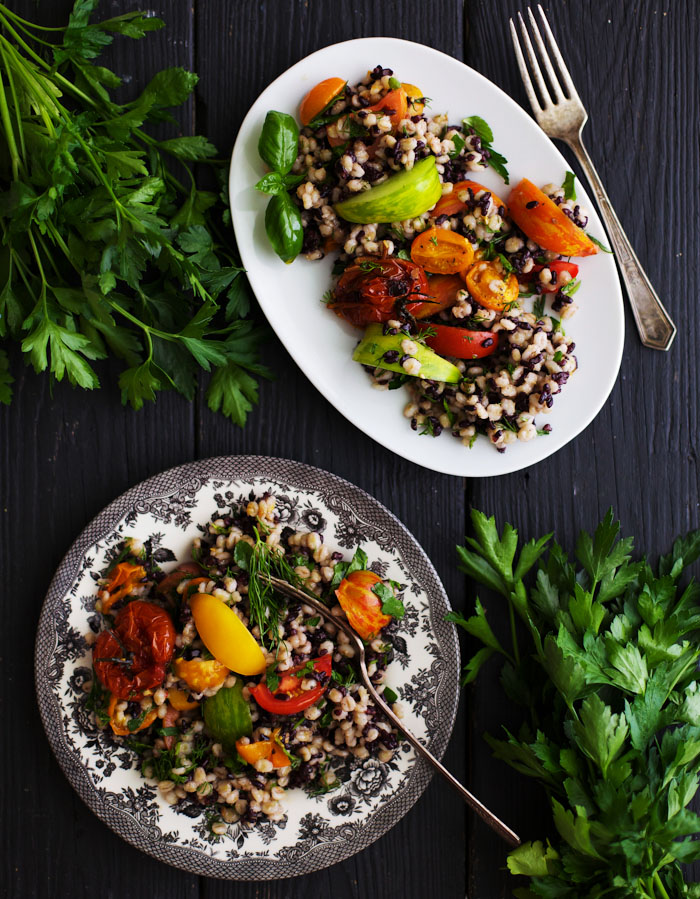
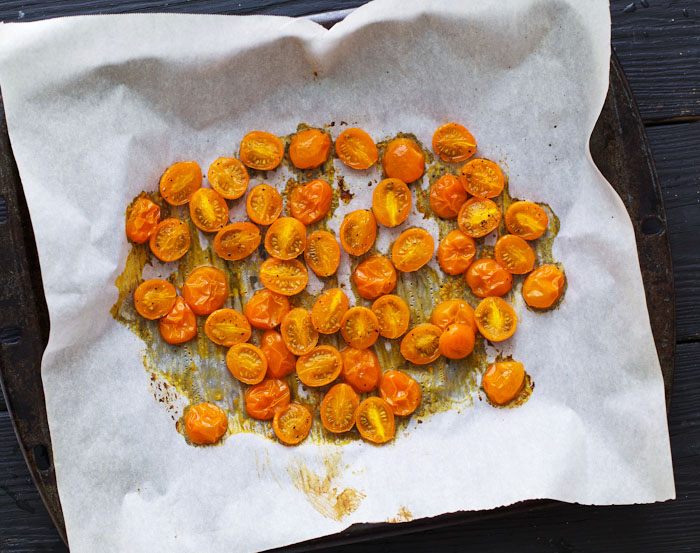



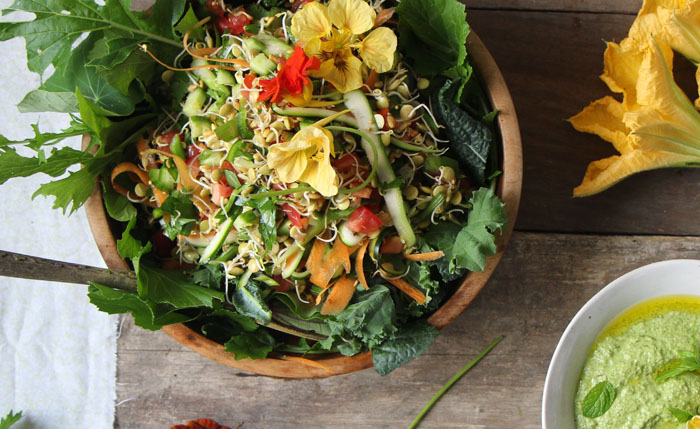
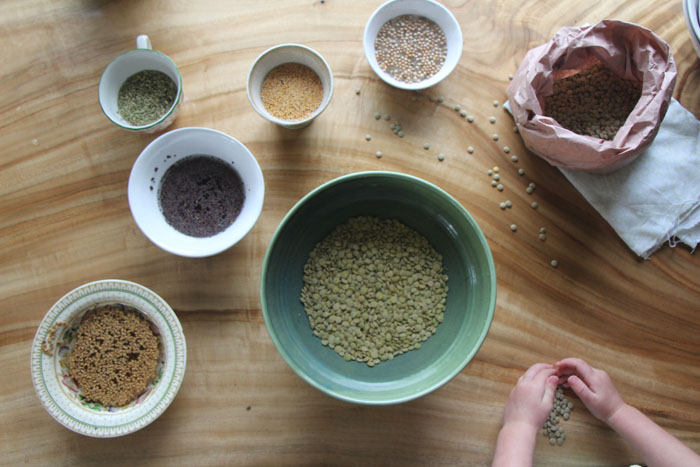
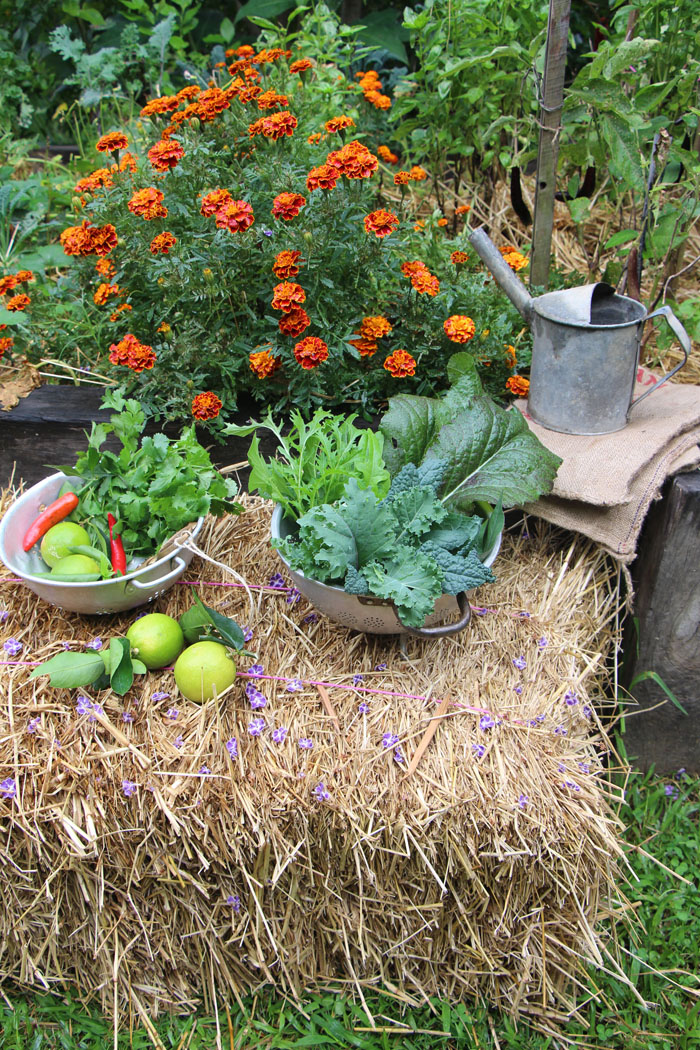
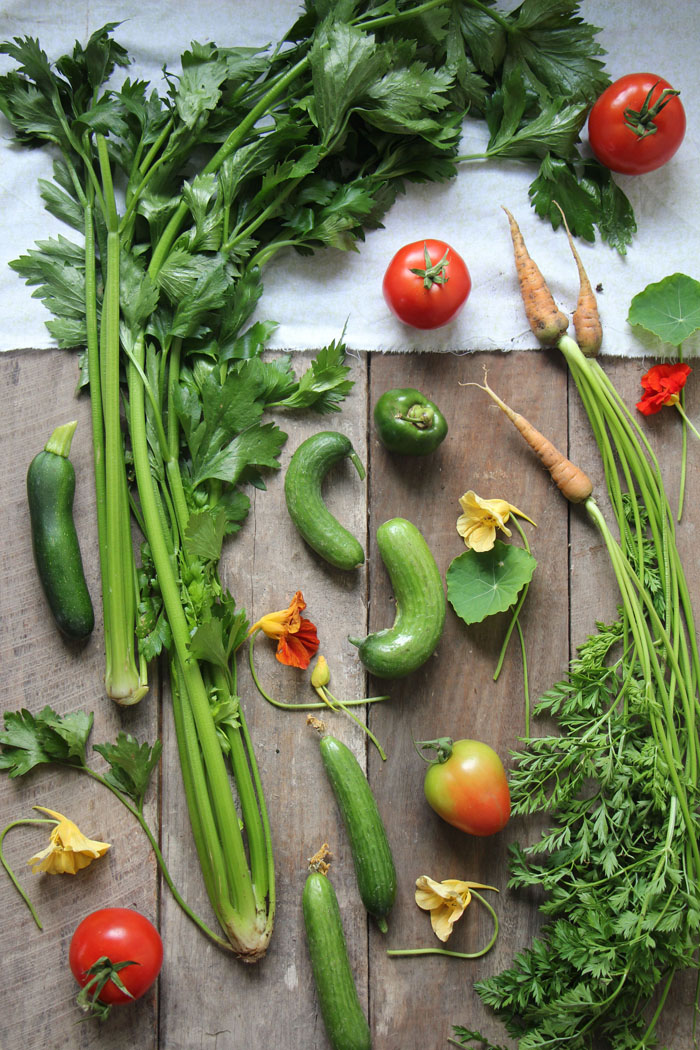
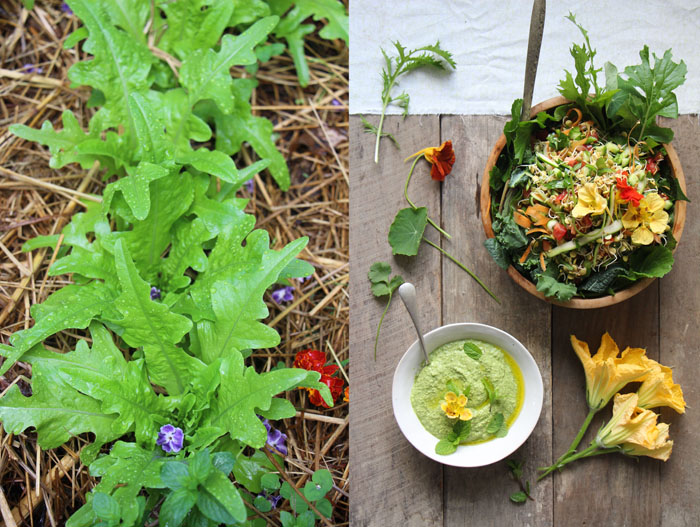
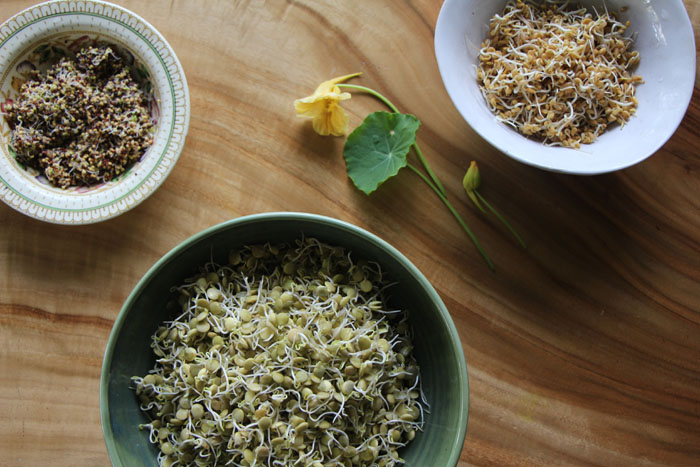
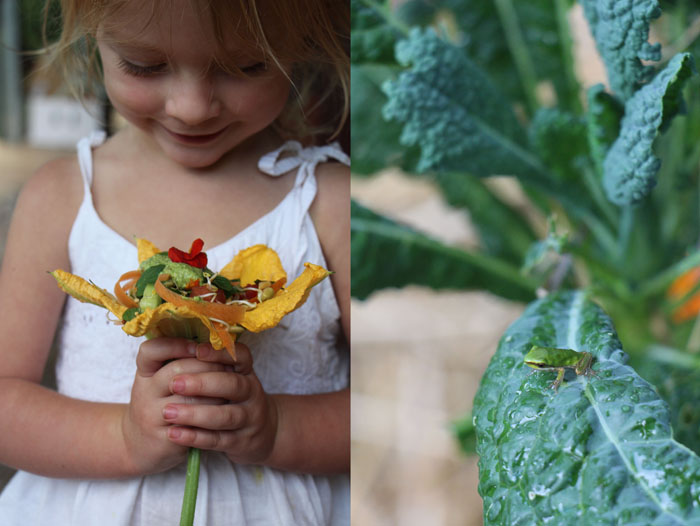


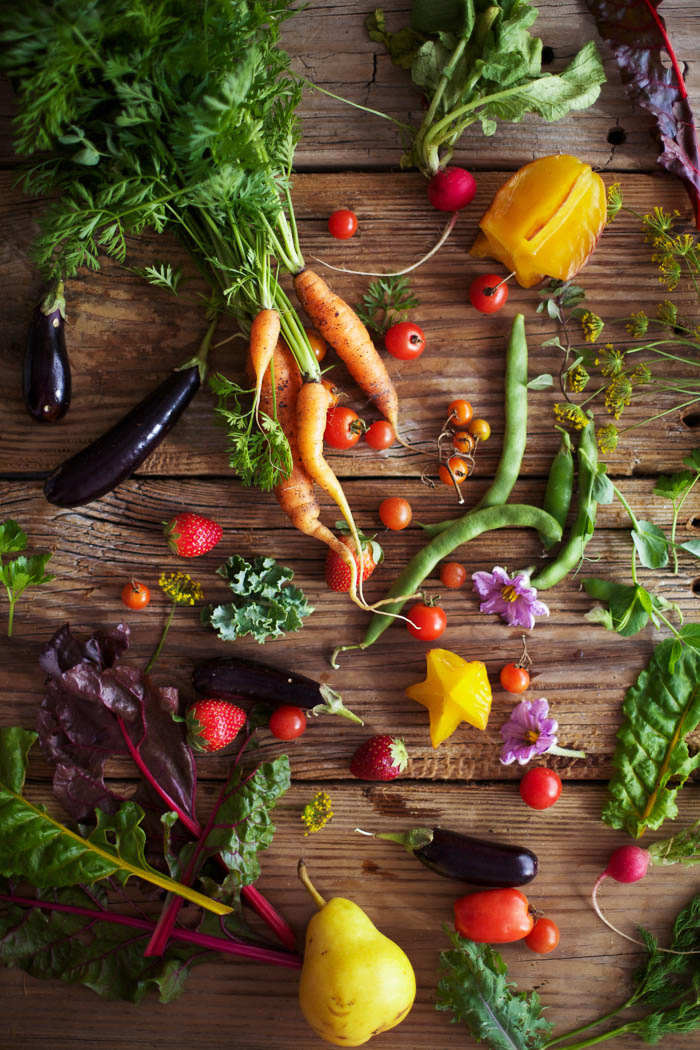
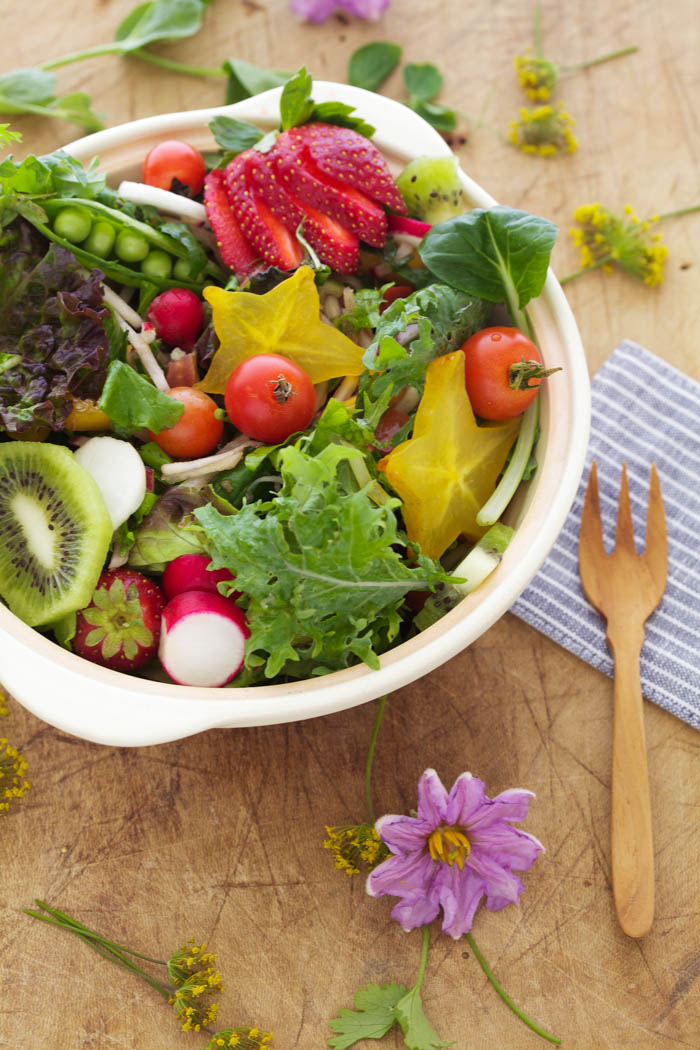
 EMAIL
EMAIL
